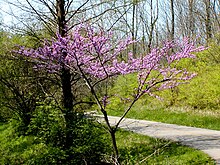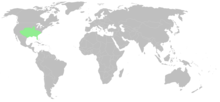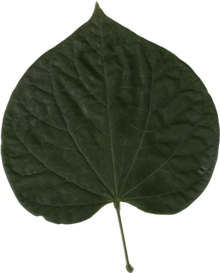
Hi Everybody!!
If you are new to 'spring tree watching', try it out this year. You just need to notice the trees and what happens when they bud out new in the Spring. In many places, one of the first trees that will catch your eye is the Eastern Redbud. The blooms pop out before the leaves so there is a high contrast of the pink flowers on dark branches against the blue sky. If this is the year you are going to begin to plant trees, this is a very good choice as it can be grown under other trees or in the sun. This friend only gets better with age and will greet you every spring with a bold statement of "I am Alive!" The photostudy is of my redbuds and linked below. Also I have shared info on the Redbud Tree from Wikipedia and instructions on how to plant a tree from WikiHow. It is the right time of year and of course, I encourage all of You to plant trees! Enjoy!


https://en.wikipedia.org/wiki/Cercis_canadensis
Cercis canadensis
From Wikipedia, the free encyclopedia
Cercis canadensis (eastern redbud) is a large deciduous shrub or small tree, native to eastern North America from Southern Ontario, Canada south to northern Florida but can thrive as far west as California.
| Cercis canadensis | |
|---|---|
 | |
| Eastern redbud near Cincinnati, OH. | |
| Conservation status | |
| Scientific classification | |
| Kingdom: | Plantae |
| (unranked): | Angiosperms |
| (unranked): | Eudicots |
| (unranked): | Rosids |
| Order: | Fabales |
| Family: | Fabaceae |
| Genus: | Cercis |
| Species: | C. canadensis |
| Binomial name | |
| Cercis canadensis L. | |
 | |
 | |
| Natural range of the Eastern Redbud | |
Description[edit]
It typically grows to 6–9 m (20–30 ft) tall with a 8–10 m (26–33 ft) spread. It generally has a short, often twisted trunkand spreading branches. A 10-year-old tree will generally be around 5 m (16 ft) tall. Thebark is dark in color, smooth, later scaly with ridges somewhat apparent, sometimes with maroon patches. The twigs are slender and zigzag, nearly black in color, spotted with lighter lenticels. The winter buds are tiny, rounded and dark red to chestnut in color. The leaves are alternate, simple, heart shaped with an entire margin, 7–12 cm (3-5 inches) long and wide, thin and papery, and may be slightly hairy below.
The flowers are showy, light to dark magenta pink in color, 1.5 cm (½ inch) long, appearing in clusters from Spring to early Summer, on bare stems before the leaves, sometimes on the trunk itself. The flowers are pollinated by long-tongued bees such as blueberry bees and carpenter bees. Short-tongued bees apparently cannot reach the nectaries. The fruit are flattened, dry, brown, pea-like pods, 5–10 cm (2-4 inches) long that contain flat, elliptical, brown seeds 6 mm (¼ inch) long, maturing in August to October.
In some parts of southern Appalachia, green twigs from the eastern redbud are used as seasoning for wild game such as venison and opossum. Because of this, in these mountain areas the eastern redbud is sometimes known as the spicewood tree.
In the wild, eastern redbud is a frequent native understory tree in mixed forests and hedgerows. It is also much planted as a landscape ornamental plant. The leaves are eaten by the caterpillars of some Lepidoptera, for example the Io moth (Automeris io).
This tree is difficult to grow as far west as western Kansas and Colorado, as there is not sufficient water. Its far northern range of growth is southern New England. It grows well inNew York State, New Jersey and southward.
- Bark: Red brown, with deep fissures and scaly surface. Branchlets at first lustrous brown, later become darker.
- Wood: Dark reddish brown; heavy, hard, coarse-grained, not strong. Sp. gr., 0.6363; weight of cu. ft. 39.65 lbs.
- Winter buds: Chestnut brown, obtuse, one-eighth inch long.
- Leaves: Alternate, simple, heart-shaped or broadly ovate, two to five inches long, five to seven-nerved, chordate or truncate at the base, entire, acute. They come out of the bud folded along the line of the midrib, tawny green; when they are full grown they become smooth, dark green above, paler beneath. In autumn they turn bright clear yellow. Petioles slender, terete, enlarged at the base. Stipules caduceous.
- Flowers: April, May, before and with the leaves, papilionaceous. Perfect, rose color, borne four to eight together, in fascicles which appear at the axils of the leaves or along the branch and sometimes on the trunk itself.
- Calyx: Dark red, campanulate, oblique, five-toothed, imbricate in bud.
- Corolla: Papilionaceous, petals five, nearly equal, pink or rose color, upper petal the smallest, enclosed in the bud by the wings, and encircled by the broader keel petals.
- Stamens: Ten, inserted in two rows on a thin disk, free, the inner row rather shorter than the others.
- Pistil: Ovary superior, inserted obliquely in the bottom of the calyx tube, stipitate; style fleshy, incurved, tipped with an obtuse stigma.
- Fruit: Legume, slightly stipitate, unequally oblong, acute at each end. Compressed, tipped with the remnants of the style, straight on upper and curved on the lower edge. Two and a half to three inches long, rose color, full grown by midsummer, falls in early winter. Seeds ten to twelve, chestnut brown, one-fourth of an inch long -can be made to germinate by first dipping in boiled (99C) water (very hot) for a minute and then sowing in a pot (do not boil the seeds); cotyledons oval, flat.[2]
Cultivation[edit]
C. canadensis is grown in parks and gardens, with several cultivars being available. The cultivar 'Forest Pansy', with purple leaves, has gained the Royal Horticultural Society'sAward of Garden Merit.[3]
Edibility[edit]
Native Americans consumed redbud flowers raw or boiled, and ate roasted seeds. Analysis of nutritional components in edible parts of eastern redbud reported that:
- the flower extract contains anthocyanins,
- green developing seeds contained proanthocyanides, and
- linolenic, alpha-linolenic, oleic and palmitic acids to be present in seeds.[4]

File:RedbudsOhio.jpg
From Wikipedia, the free encyclopedia
Detail of buds




Link to photostudy in G+Albums:
https://plus.google.com/u/0/photos/117645114459863049265/albums/5669486988101030977

...this is brendasue signing off from Rainbow Creek. See You next time!

O+O
http://www.wikihow.com/Plant-a-Tree
How to Plant a Tree
Edited by Erika Altek, Jack Herrick, Ben Rubenstein, Krystle C. and 62 others
Planting a tree isn't as simple as just digging a hole and throwing the tree in it. If you want the tree you're planting to survive and thrive, here's what to do:
-
1Select the right time of year for planting the tree. Do not plant in late spring or summer because the heat will stress the plant and may cause it to die. The best time to plant a tree is fall (autumn) or early spring.
-
2Check to see if there are any local requirements concerning digging deep holes if you need to dig near telephone and other cables (for example, in urban areas). We have already contacted Miss Utility and have been cleared to dig.
-
3Choose a suitable tree for the region, climate, and space.
- Research local cultivars of species native to your area. If you are willing plant a non-native species, consider carefully why. We have chosen all native trees which will do well in our area.
-
4Prepare the hole. Take a suitable shovel and dig a hole that is 4-5 times the width of the root ball, more than enough so it will fit, and give room for the fresh roots to grow without stress. This lets the roots ease in more easily and begin to grow outwards into the soil. No need to cut off the wire root basket if there is one, the roots will grow through and it will prevent damaging the root ball during planting.
- Try to dig the hole with a small "pedestal" of dirt in the center of the hole where the tree will rest. The hole should be a little deeper around the edges but there should be a pedestal of dirt in the center where the root ball sits. This pedestal prevents the root ball from sitting continuously in water. Any excess water will naturally flow to the deeper areas of the hole around the edges where the roots can drink from if needed. Having a pedestal in the center of the hole is very important since one of the major reasons why trees die is "drowning", meaning the tree is getting too much water and the root ball is sitting in a pool of water. The point where the tree comes out of the ground should be slightly higher than the ground around it. Slightly higher means 1/4 to 1/2 inch. This prevents water from collecting next to the base of the trunk which causes the tree to rot.
- Use the garden cultivator to loosen the dirt all around the hole to make it easier for the roots to spread.
-
5Prepare the tree for planting. The process is slightly different for a small tree and a large tree:
- If it is a small tree, then you can turn it upside down gently to get it out of the pot. You could also cut some plastic containers to remove them.
- If the tree is larger and has a net or a hessian or rope bag, you might need to use large scissors or a sharp knife to cut through the packaging. Avoid handling the tree with the burlap off. Put it in the hole, then cut the burlap and rope from around the trunk of the tree, leaving the wire basket. The goal is to keep as much dirt around the roots as possible; moving the tree more than absolutely necessary can easily cause air to get to the roots and dry them out, even inside the root ball.
- Don't leave a tree's roots out of its container or burlap for too long. Especially in sun and wind, it could dry out and damage the roots.
-
6Place the tree into the hole gently. Be sure the hole isn't too deep or too shallow. The ground level of the plant in the pot should match up with the ground level after you fill the hole in. Do not bury over the crown (where the stem changes to root) or leave any roots exposed.
- You can place the handle of your shovel flat across the hole from one side to the other to measure whether the crown is level with the surrounding soil before filling in the hole.
-
7Use some compost or composted manure if needed. If the soil that you currently have is not rich, has clay-like qualities or if it has the consistency of dust or sand, the addition of manure or compost will give the tree a great start in life. Backfill three quarters of the hole with existing dirt, one quarter with compost or composted manure.
-
8Resist the temptation to use a commercial fertilizer; it tends to overboost the tree and make it "burn out", less likely to do well over the long term. A great benefit to new trees, however, is an organic mixture that includes micorrhizae, beneficial fungi that enhance a tree's uptake of soil nutrients. It may also include rock phosphate, a natural root-growth enhancer.
-
9Give fruit and nut trees extra attention. Adding manure or compost is essential if you are planting a fruit or nut tree. Backfill two thirds of the hole with existing dirt and one third with compost or composted manure for each fruit or nut tree.
-
10Water the newly planted tree. Allow settling, backfill the remaining soil, and water again. This will eliminate air pockets. Water one gallon (3.7 liters) for every six inches (15 cm) of tree height.
-
11Mulch, mulch, mulch! Cover the planting hole with 1-3 inches (2.5 cm - 7.6 cm) of shredded hardwood or leaf mulch. Keep the mulch 2-3" away from the trunk or the trunk will rot. Don't over-mulch the tree, either. A few inches are enough to keep water in and most weeds out. Mulch a circle out to the drip line, about the same width as the tree's leaves.
- A visible patch of mulch also helps remind people not to step or mow or run astring trimmer too close to the tree.
-
12Water it again. After the planting is finished come back in about an hour and water one more time.
-
13Stake the tree if necessary, for about the first year. Make sure that whatever stakes you use are tied loosely to the trunk and do not dig into the bark or tighten around the tree. Remove the stakes once the roots have a chance to become established, after about the first year. Staking protects the tree against blowing over in the wind, and it can also help to remind people moving around the tree not to run into it.
-
14Keep watering your tree for the first few years as it gets established.Depending on the climate and your area, it will need weekly watering until the roots are established. To form deep roots, water deeply. A long, slow trickle of water will water more deeply than a quick sprinkling. Remember, deep roots help your tree to resist droughts and winds. Let the ground dry out, at least somewhat, between watering.
-
15Enjoy the tree as it grows over the years with you, your family and friends.Appreciate its shade and beauty and thank yourself for adding another tree to the world






No comments:
Post a Comment
Hi Everybody! Please say hello and follow so I know you are here! Due to the inconsideration of people trying to put commercials on my blog comment area, I have restricted use of anonymous posts. Sorry that some hurt all.
My public email is katescabin@gmail.com No spammers or trolls